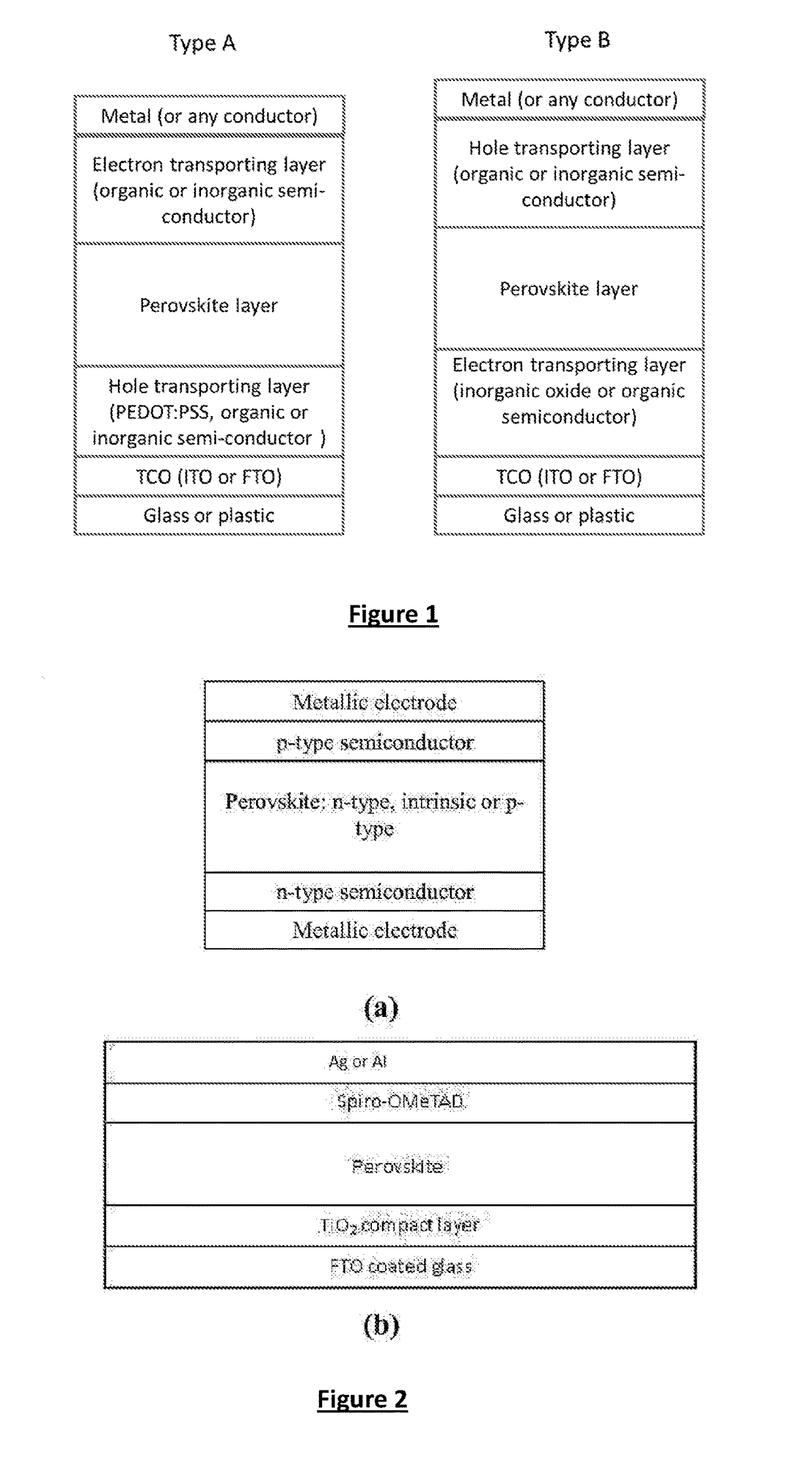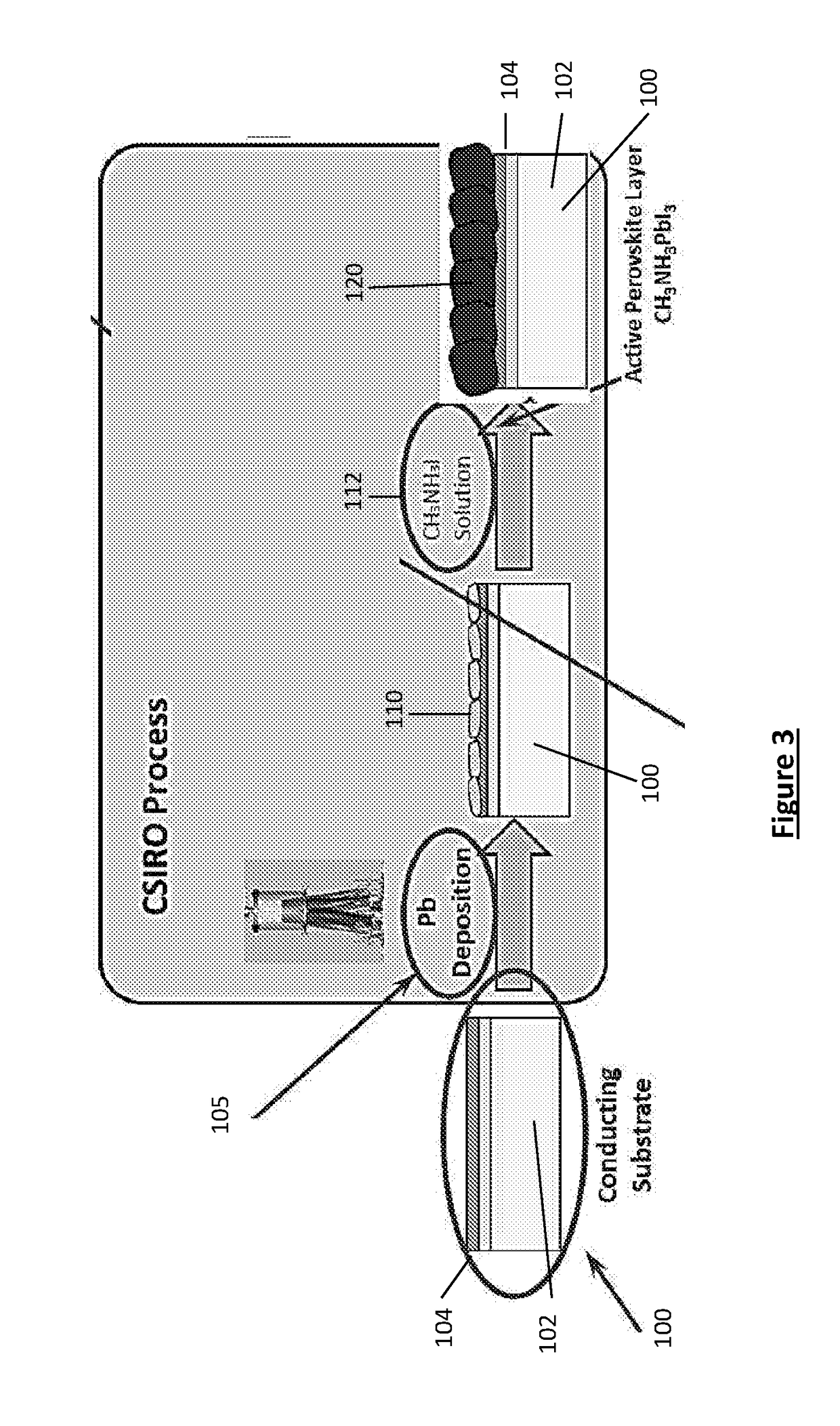Process of forming a photoactive layer of an optoelectronic device
- Summary
- Abstract
- Description
- Claims
- Application Information
AI Technical Summary
Benefits of technology
Problems solved by technology
Method used
Image
Examples
example 1
Electrochemical Deposition of Pb Thin Film Seed Layer for Planar Perovskite Solar Cells
[0263]In this example, a thin metallic Pb seed layer is electrochemically deposited on an n-type compact blocking layer, in this case TiO2, as a precursor for a perovskite solar cell. The deposited Pb seed layer is then chemically converted to the photoactive perovskite material.
[0264]It should be appreciated that whist demonstrated for planar perovskite solar cells, the method and techniques exemplified can equally be applied to non-planar perovskite solar cells configurations for example the inclusion of a mesoscopic thin-film of nanoparticles for example TiO2, Al2O3, ZrO2 or the like.
1.1 Electrochemical Deposition of Pb
[0265]The electrochemical deposition equipment included the following:
[0266]An electrolyte consisting of a 0.01 mol / L solution of Pb(NO3)2 as Pb source and 0.1 mol / L KNO3 as inert conducting electrolyte (also known as supporting electrolyte.
[0267]A working electrode (that where t...
example 2
Thermal Evaporation of Thin Pb Film as Perovskite Seed Layer for Planar Perovskite Solar Cells
[0275]In the following two examples (2.1 and 2.2), a thin metallic Pb seed layer is formed by thermal evaporation of Pb and condensation onto an n-type compact blocking layer (in this example either ZnO or TiO2) as a precursor for a perovskite solar cell. The seed layer once deposited is then chemically converted to the photoactive perovskite material.
2.1 ZnO Blocking Layer on Indium-Doped Tin Oxide (ITO) Substrate Embodiment
2.1.1 Substrate Preparation
[0276]The ITO substrate was cleaned by successive sonication treatments in detergent (Hellmanex, 1% in milli-W water), pure milli-Q water and isopropanol.
[0277]ZnO blocking layer was applied by spin casting a suspension of ZnO nanoparticles in 1-butanol onto the cleaned ITO substrate. The film was annealed at 100° C. After annealing, the ZnO film was treated by plasma treatment for 1 hour. This was necessary for film stability.
2.1.2 Pb Seed La...
example 3
Embodiment of TiOx Blocking Layer Formation
[0292]A device was produced following the method outlined in Example 1. However, in this example prior to a thin metallic Pb seed layer being electrochemically deposited onto the substrate, the substrate requires a thin-layer to reduce electrical recombination and hence a ‘blocking layer’ is deposited prior to deposition of the Pb seed layer. For large area embodiments, typical spray-cast or screen-printed TiO2 thin-films can be replaced by the use of an evaporated thin-film of Ti, introduced under an oxidising environment using DC magnetron sputtering. This results in a controlled thickness of film of semi-amorphous TiOx.
[0293]A cross-section SEM depicting the thin-layer of TiOx deposited on the surface of FTO glass by sputtering is shown in FIG. 11. This SEM topographic images shows that the deposition of TiOx results in a uniform coating on FTO. The series of coating thickness are shown in FIG. 12 which confirms a thin-film results that ...
PUM
| Property | Measurement | Unit |
|---|---|---|
| Temperature | aaaaa | aaaaa |
| Temperature | aaaaa | aaaaa |
| Temperature | aaaaa | aaaaa |
Abstract
Description
Claims
Application Information
 Login to View More
Login to View More - R&D
- Intellectual Property
- Life Sciences
- Materials
- Tech Scout
- Unparalleled Data Quality
- Higher Quality Content
- 60% Fewer Hallucinations
Browse by: Latest US Patents, China's latest patents, Technical Efficacy Thesaurus, Application Domain, Technology Topic, Popular Technical Reports.
© 2025 PatSnap. All rights reserved.Legal|Privacy policy|Modern Slavery Act Transparency Statement|Sitemap|About US| Contact US: help@patsnap.com



